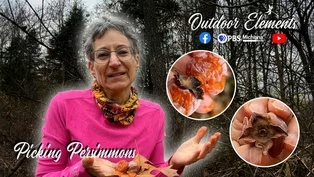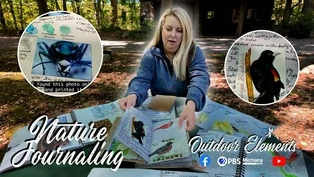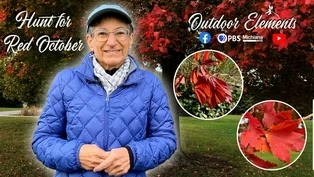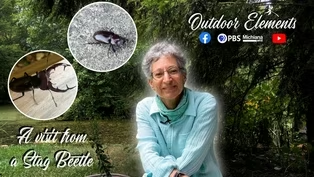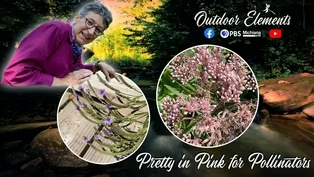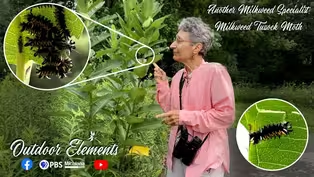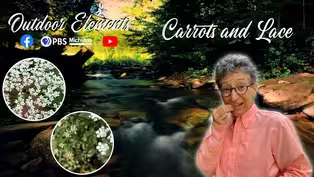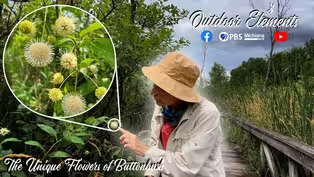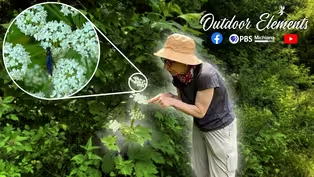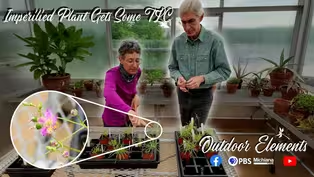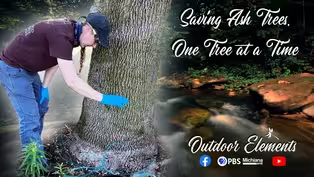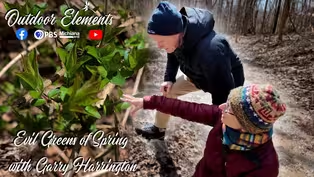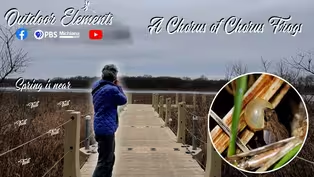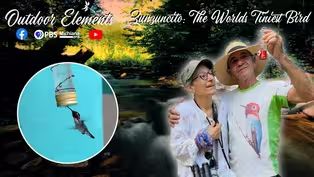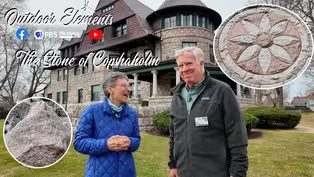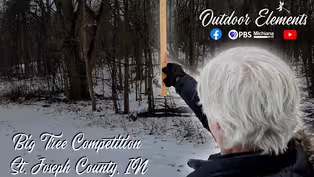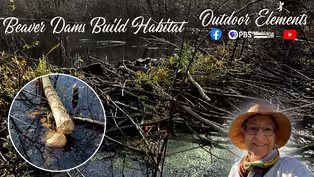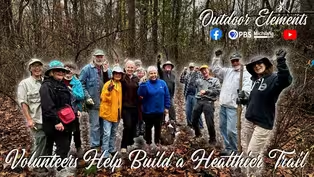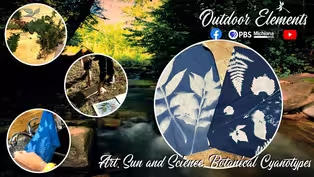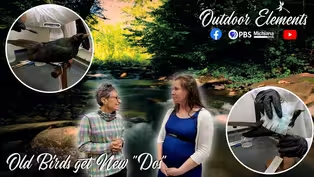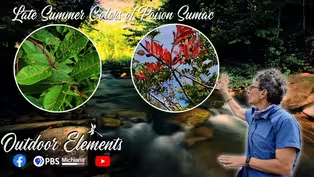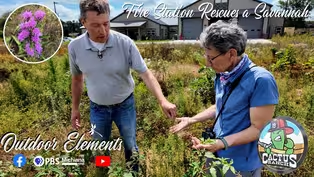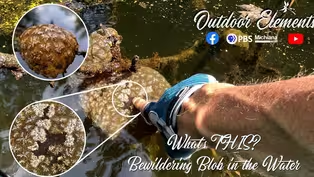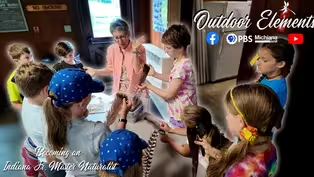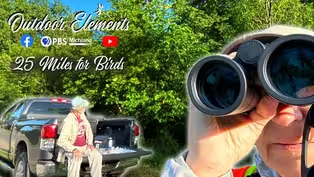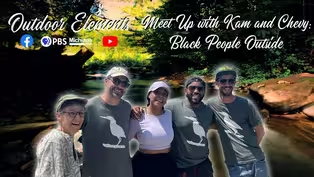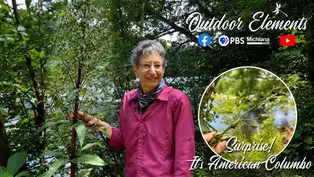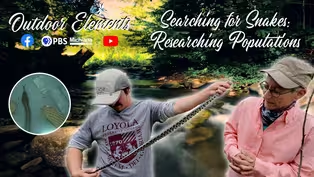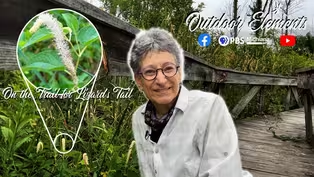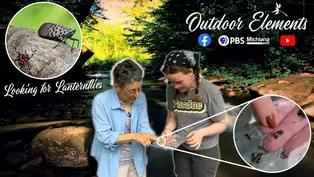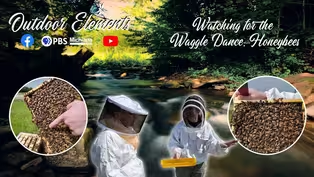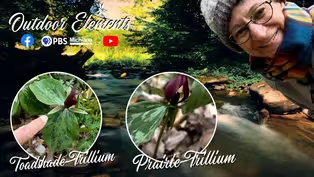Outdoor Elements
Urban Transformation at Milkweed Gardens
Clip | 17m 11sVideo has Closed Captions
No description
<div>🌿✨ In downtown South Bend, a once-overlooked space is being reimagined into something truly special! Milkweed Gardens is transforming into a vibrant green space for the whole community to enjoy — thanks to the hard work of partnering organizations and dedicated volunteers. 💚</div><div>Rachel Mospan of Herstoric Development is helping lead the way, and in this epi...
Problems playing video? | Closed Captioning Feedback
Problems playing video? | Closed Captioning Feedback
Outdoor Elements is a local public television program presented by PBS Michiana
Outdoor Elements
Urban Transformation at Milkweed Gardens
Clip | 17m 11sVideo has Closed Captions
<div>🌿✨ In downtown South Bend, a once-overlooked space is being reimagined into something truly special! Milkweed Gardens is transforming into a vibrant green space for the whole community to enjoy — thanks to the hard work of partnering organizations and dedicated volunteers. 💚</div><div>Rachel Mospan of Herstoric Development is helping lead the way, and in this epi...
Problems playing video? | Closed Captioning Feedback
How to Watch Outdoor Elements
Outdoor Elements is available to stream on pbs.org and the free PBS App, available on iPhone, Apple TV, Android TV, Android smartphones, Amazon Fire TV, Amazon Fire Tablet, Roku, Samsung Smart TV, and Vizio.
Providing Support for PBS.org
Learn Moreabout PBS online sponsorshipWe're going to learn about a really interesting space on the south edge of downtown South Bend that literally, as we speak, is being transformed from an empty lot to an urban oasis.
So we're with Rachel Band right now, and she's going to share a little bit about what's happening here at this site.
And Rachel, we're kind of standing between two buildings.
We're going to talk about those.
But tell us where you are right now.
We're where we stand.
Yeah.
So we are here on the future site of the Milkweed Commons pocket park.
It's about a third of an acre of vacant lot.
And between two buildings, like you said.
520 South Michigan is the address.
And we are just south of Monroe and South Michigan in downtown South Bend.
Yeah.
Kind of like just near the post office, actually, if folks know where that is.
So I mentioned the two buildings as you did as well.
And they're kind of beautiful brick buildings.
Tell me about those.
Yep.
So, I am, co-owner of Historic Development.
We are doing an entire block development here on South Michigan.
So four parcels in total.
The two buildings are historic mixed use buildings.
They were built in the 1920s.
Both have been vacant for decades.
And so we're in the process of renovating those buildings, beginning with the monarch building.
Which is going to house a coffee shop on the first floor and event space in the back, and four residential units upstairs.
The Hope building will be next.
And that will be food centric.
So we'll have a fresh food mart and also, some prepared food vendors, a commercial kitchen with residential on the second floor as well.
And in between is kind of this empty vacant lot, which was kind of an open slate for you.
So that was about that.
Exactly.
So, when we got the buildings, we knew we really also wanted to maintain control of the vacant lot.
There's a lot of development happening in this area.
A lot of new construction is on the way.
And we knew we wanted to maintain a green space, so we were able to purchase this lot.
It's a third of an acre in between the two buildings, the site of formerly demolished buildings, and has just been neglected for decades.
So we are installing a a pocket park, so it'll be a community green space, lots of amenities for the community need native plantings, pathways will have seating eventually a public restroom.
Just trying to make a space that really works together with the buildings to provide an entire package for the neighborhood.
And I think when I was chatting with you about this plan a while back, even though this is known as Monroe Park, there's really no park here.
But this will serve as a community park, not just for the buildings, except for the whole neighborhood.
Yep.
It'll be open to the community, and we're really designing the amenities that we put in the park.
Based on feedback from the residents that Monroe Park neighborhood, has seen a lot of disinvestment over the years, but there are longtime residents who have really invested in the community themselves.
And, this is this park is for them.
And what's great about today is that you've got a whole bunch of volunteers getting ready to show up, to do a whole bunch of planning.
So how about if I touch base with you in a little bit and, volunteers can assemble and we'll see what's going on.
Sounds great.
Thank you.
Thanks.
Rachel, there's, like, a buzz of activity going on back there.
What is happening back there?
Looks beautiful.
Yep.
So here we are, planting one of the garden beds.
We have three different garden beds that were prepped here on site.
And we are we partnered with Spalding Restoration.
Are local ecological restoration and landscaping company.
And Lindsay is the CEO of Spalding.
And she also is on our board for Milkweed Gardens.
And she's hard at work there in the blue shirts.
So she's working away.
Yep.
So she has selected all of our plants for the site.
They are all native to Indiana, to this area, and meant to support the pollinators that we have here in Indiana.
And so she has designed a matrix of plants, flowers and grasses to go into each of the garden beds.
So we've got the team putting all of the plants into place according to her plan.
Her plan.
And you mentioned that they're all native and that will support the pollinators.
And basically, I think you mentioned earlier this site for this is like milkweed gardens, right?
Meadow gardens.
And there's kind of a metaphor there for the space in the middle of the monarch, right.
Exactly.
So the first building that we purchased on this block is the Monarch Printing Co, former headquarters, when it was built in the 1920s.
And we are keeping that name.
So it's the monarch building.
And when we were choosing how to name this block and create this destination, we chose the name milkweed because milkweed is the primary nutrient for the monarch butterfly.
And we want this block to serve as a metaphorical nutrient for the neighborhood.
I also like it because when I think about monarch butterflies and their life cycle and the metamorphosis right from like, this little kind of lowly caterpillar to this amazing winged insect, it's kind of like what's happening here.
Right here.
Yeah.
You're emerging a beautiful space out of literally, as you said, there was a building that was demolished right here where we're standing.
Exactly.
So there's a beautiful gravel path that winds through here, which is really lovely.
And you mentioned earlier that other amenities in this pocket park, in your vision.
What might that be?
So we will have outdoor seating here.
We will have, pad for music, for live entertainment to be enjoyed here.
We'll have the lawn area, for picnicking.
In the long term, we also are planning to build a public restroom on the site.
That's something that doesn't really exist in this area, and it's really needed.
We'll have some shade structures.
We'll have signage as well.
Educational signage about what we've done here so that anybody who comes in is curious about what we did, why we did it, and maybe wants to take a piece of it home with them or into their own community, would be empowered to take the idea and replicate it elsewhere.
Yeah, that's really great.
The volunteers that are here and, other partners who are who are these?
Some of these folks, and they find out about it.
And yeah, so we have a number of community partners.
So Shirley Hines Land Trust has been an early partner with us, their land trust in the northern Indiana area, they have been a strong partner providing expertise, manpower.
And we also have partnered with wild ones.
We have gotten input from their organization and volunteer support as well.
We've been working closely with the city of South Bend in a number of areas.
Many departments there have been involved, but in particular for today, we partnered with the team that is executing the USDA Tree Canopy grant for the city.
And so all of the green material here today, the plants, the trees, the shrubs, came through the tree canopy.
Grant.
So we should mention that tree canopy grant is kind of a city initiative to expand, literally the number of trees in South Bend for a lot of reasons.
You know, cooling air quality, better property values and just green space.
And so basically you're saying this project is part of that overall.
That's right.
Yeah.
That's right.
And they were, instrumental in choosing what trees came in here.
So there's a logic behind each of the species to encourage biodiversity to provide habitats for different types of animals.
Moths.
One of the species of trees, houses and supports, supports and supports like a dozen different species.
So and that's, that's really important that the native trees are really kind of incubators for so many different pollinators, which is great that you're focused on that.
Okay, great.
Well, I'm going to, just kind of go check out the volunteers here.
Maybe I'll catch up with Lindsay as well.
And then I'll touch base with you in a minute or two.
Okay, great.
Thanks.
Wow.
There's a lot of stuff going on here, and we've caught up with Lindsay.
Hi, Lindsay.
Hi.
How are you?
Can you tell me everything that's like.
You're, like, acting as the crew leader.
Kind of.
Here?
Yes, I volunteer.
Yes.
What?
Rachel told me you were the one that selected all the plants.
And they're all native, which is wonderful.
So tell me, what in general is being planted and how you selected.
Absolutely.
So my focus with these garden spaces was everything is perennial.
It's going to come back year to year because that's going to make a healthier habitat.
Also everything that I, I created this matrix so to say so that we have blooms all the way from May through October.
So you've got something for the early season pollinators all the way through to the late season pollinators.
And also for the human visitors absolutely make it beautiful for the time, beneficial for everybody.
I think, succession of blooms is going to be enjoyed by everybody.
Absolutely.
Yeah.
So like right now I see all these, like, little grassy things going in.
What are those?
Yes.
So these are, it's a native sedge.
There are a lot of native sedges.
I love using sedges as a groundcover between the flowers.
It makes maintenance a lot easier, less weed pressure.
And they will just fill in and create this green carpet between the flower interest.
Okay, so this is carrick's.
Wonderful.
Okay.
Yes.
Great.
And there's some shrubs and some trees as well.
So what kinds of shrubs and trees do.
Yeah.
So in this bed specifically there is black choke berry.
One of my favorite lower growing shrubs, maybe 4 to 6ft tall.
It turns bright red in the fall, which is why I love it.
I tell people, is an amazing native instead of, burning bush because you still get that color burning bush reminder not need not need an invasion.
Exactly.
So not a great one to have in the landscape.
But this is a great resource.
This is an amazing replacement.
It has spring flowers.
It even has berries in the summer for the birds.
And then it's got that bright color for the humans to enjoy as well.
Yeah, yeah.
And then it looks like there's going to be some taller trees as well, right?
Yeah.
So the law also has red buds.
It's got a service berry right behind us again, an amazing one for the birds and the berries.
We even put a hackberry in there because they are super beneficial for moths and supporting it.
And people tend to overlook that as a native street, a native tree.
Yeah.
And that'll provide a lot of shade because they have to get much right now.
There's not a lot of shade here.
So that we really wanted to create some canopy.
And the nice thing about all these native shrubs and trees are they are drought tolerant.
They can handle this poor soil because this is an empty lot.
And it it's we have some harsh conditions here that they need to endure.
Yeah.
Great.
Well, it's so great that you help figure out the plants.
You're helping to coordinate the volunteers.
Spaulding restoration does amazing work.
Thank you.
Thank you for supporting this community.
I really appreciate it being a part of it.
It means a lot.
Yeah.
That's wonderful.
That.
So now I'm with Zach and Zach.
I've seen, like, people running around with cameras.
You're got a camera?
I in South Bend is actually a partner in this project in many levels.
And tell me specifically what's going on with all the filming.
Yeah, yeah.
So, the center for Sustainable Future is collaborating with the city and their efforts to, expand the urban tree canopy through this grant.
And so our partnership is, kind of twofold.
We are over, a few years documenting and measuring the environmental impact of expanding an urban tree canopy, but also the social impacts.
And I'm as a sociologist, very interested in that.
And so I'm teaching a class this semester.
The class is called Film Society and the environment.
And students in this class are not only working on their own independent projects.
Thinking about how we interact with nature, but also collaboratively documenting with some of the organizations, including historic development, but also, the South Bend Greenway Conservancy and Land Lab and a few others.
These different organizations that are partnering with the city to plant trees, change their landscaping, thinking about urban change, social change, environmental consciousness, and all of this.
So how do we, adapt to the future preserving features of the past, but also thinking about, development in a new way, you know, balancing social, environmental, cultural and economic interests.
So a whole aspect to this project beyond like tangible stuff that you see here, which I think is amazing.
That's right.
And I'm so excited because we're in this segment, we're using some of the footage that you and your students have captured, which I think is great fun.
Yeah.
So over the semester, I have, sent students out to different events like this tree planting and landscaping today, throughout the rest of the season will be, practicing our camerawork, our film work.
A lot of us are amateurs at this, but we know that good storytelling, good, documenting can really convey, especially across the city, ways in which we're all partnering, collaborating.
And, so we're hoping to to tell some stories through our cameras and making the world a better place.
Right?
Yeah.
A little bit of time.
That's wonderful.
Thanks, Zach.
I'm going to now touch base with Rachel, who's going to, I think hopefully tell a little bit more about the amazing partners that are going on here.
But thank you for doing your part with the students.
It's wonderful work.
Yeah.
It's great.
Yeah.
Thanks a lot.
Rachel.
In addition to Spalding Restoration, which is doing lots of support work here, there's other partners like universities that you've gotten involved.
That's right.
So I USP has been a partner.
We had a summer intern from ISP.
She helped with site planning, drainage testing and some of the educational signage that will go in here.
She drafted the content for that.
So, she was great to have on the team.
And we also had a group of volunteers from Notre Dame come out a few weeks ago, and they helped spread all this limestone that, you see, it was a very labor, labor intensive job.
We are happy to have their help.
That was Siegfried Hall from Notre Dame.
And then we also have some very local support.
So we're in Monroe Park.
The Monroe Park Neighborhood Association has been a great partner.
We've had their tool trailer onsite for each of our workdays, full of outdoor yard work, tools, everything that you could need.
And then we also have partnered with Disney's house.
So they are right across the alley from here, and we've hired them to do maintenance and cleanup and keep an eye on the site.
So that, you know, as we're getting it built out, it stays looking nice.
That's wonderful.
And obviously, getting folks in the neighborhood involved helps establish spine.
And they feel like they have an ownership in the site.
Exactly.
We're constantly talking to residents of the neighborhood to determine what what do they want to see here?
Because that's what we want to put in.
Good point, good point.
So let's look ahead maybe five years from now.
And what do you see here?
You know, I hope it'll all be green.
Yeah.
Lots of colorful flowers to enjoy.
I hope people come here.
Enjoy it day and night.
Come for live entertainment.
Come to have a picnic where we're hoping to have little mini pop up festivals and food trucks and, all types of events like that for the community to happen here.
And of course, in both buildings, monarch and Hope will have, the amenities that you mentioned as well.
So literally taking a rough space and turning it into a beautiful space is such a great vision.
Yeah, yeah.
Thank you.
Well, congratulations on even getting this far because it looks fantastic and it's going to be fun to follow Milkweed Gardens as it continues to grow.
And remember, you can find your own outdoor elements when you visit area parks and nature centers and pocket parks like this one.
Thanks so much, Rachel.
Thank you.
Video has Closed Captions
Clip | 3m 38s | 🍂✨ Out on a fall walk in the woods, Evie stumbled upon a sweet seasonal surprise — (3m 38s)
Urban Transformation at Milkweed Gardens
Video has Closed Captions
Clip | 17m 11s | No description (17m 11s)
Video has Closed Captions
Clip | 11m 50s | 🌿🖊️ It’s time to slow down and connect with nature! In this episode of Outdoor E (11m 50s)
Video has Closed Captions
Clip | 3m 20s | 🐔👀 There’s a possum in the hen house! 🐾 On this episode of Outdoor Elements, E (3m 20s)
Video has Closed Captions
Clip | 2m 57s | 🍁 It’s that time of year when nature puts on its most colorful show! 🌳 In this epi (2m 57s)
Video has Closed Captions
Clip | 3m 36s | 🌿🪲One of our awesome viewers spotted a beetle making its way across the driveway and (3m 36s)
Video has Closed Captions
Clip | 3m 24s | A viewer shared a fascinating video of a Paintedhand Mudbug, and Evie dives into the detai (3m 24s)
Pretty in Pink for Pollinators
Video has Closed Captions
Clip | 5m 3s | At Lydick Bog Nature Preserve, Evie spots a burst of pink in a wetland. She explores these (5m 3s)
Another Milkweed Specialist: Milkweed Tussock Moth
Video has Closed Captions
Clip | 4m 36s | No description (4m 36s)
Video has Closed Captions
Clip | 3m 43s | Evie spotted Pointed-leaf Tick-Trefoil and shares how to identify this plant. (3m 43s)
The Unique Flowers of Buttonbush
Video has Closed Captions
Clip | 3m 58s | Evie finds Buttonbush at Spicer Lake Nature Preserve (3m 58s)
Saving Ash Trees, One Tree at a Time
Video has Closed Captions
Clip | 11m 16s | No description (11m 16s)
Bringing Bees Back to the Nature Center
Video has Closed Captions
Clip | 6m 10s | No description (6m 10s)
Gathering for Science: An Environmental Research Symposium
Clip | 10m 27s | Evie stops by the St. Joseph County Public Library during their Earth Day celebration to c (10m 27s)
Surprising Color in the Woods: Blue Stain Fungi
Video has Closed Captions
Clip | 3m 48s | No description (3m 48s)
Maple Sweet Treat for Ants | Outdoor Elements
Video has Closed Captions
Clip | 1m 34s | A sweet surprise in the woods! (1m 34s)
Evil Greens of Spring with Garry Harrington
Video has Closed Captions
Clip | 12m 56s | Things are greening up in the spring woods, but it’s not necessarily a welcome sight. (12m 56s)
Volunteers Help Build a Healthier Trail
Clip | 6m 9s | At Lydick Bog Nature Preserve, volunteers make a big difference in protecting and maintain (6m 9s)
Art, Sun and Science: Botanical Cyanotypes
Clip | 6m 49s | Experimenting with cyanotype fabric brings nature to life in beautiful, sun-printed design (6m 49s)
Clip | 3m 57s | Evie shares a fun and simple craft idea using autumn leaves that the whole family can enjo (3m 57s)
Late Summer Colors of Poison Sumac
Clip | 1m 59s | Watch out for this colorful danger at Lydick Bog Nature Preserve! (1m 59s)
What's THIS? Bewildering Blob in the Water
Clip | 5m 8s | What’s that mysterious blob in the water (5m 8s)
Clip | 7m 14s | Find out how thousands of volunteers help the US Geological Survey teams and other resourc (7m 14s)
Meet Up with Kam and Chevy: Black People Outside
Clip | 5m 18s | Meet the inspiring creators behind Black People Outside. (5m 18s)
Surprise! It's American Columbo
Clip | 5m 14s | Explore the unique features of the American Columbo. Discover its habitat, appearance, and (5m 14s)
Searching for Snakes: Researching Populations
Clip | 13m | Delve into the world of snake population research in northern Indiana and discover the met (13m)
On the Trail for Lizard's Tail
Clip | 3m 10s | We are at @SpicerLakeNaturePreserve to learn about the fascinating plant known as Lizard's (3m 10s)
Clip | 7m 35s | Uncover the impact of the invasive Spotted Lanternfly. (7m 35s)
Clip | 3m 6s | Love it or hate it, that flying white fluff looks like “Snow in June!” (3m 6s)
Watching for the Waggle Dance: Honeybees
Clip | 12m 32s | Join Evie as she interviews Morgan Carr-Markell, Assistant Professor at Saint Mary's Colle (12m 32s)
Clip | 5m 1s | Join Evie in Outdoor Elements as she dives into the world of wildflowers, comparing Prairi (5m 1s)
Providing Support for PBS.org
Learn Moreabout PBS online sponsorshipSupport for PBS provided by:
Outdoor Elements is a local public television program presented by PBS Michiana
